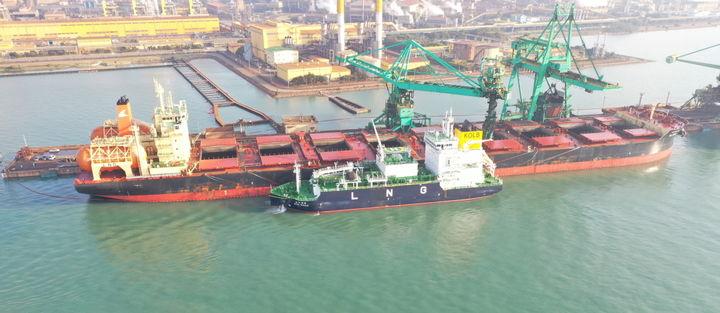Successful simultaneous LNG bunkering and cargo operations within Korea’s first trade port
| Date created | 2023-10-31 17:35:15 | Hit | 254 |
|---|---|---|---|
 [Today Energy Reporter Park Chan-gyun] On the 28th, simultaneous operation of liquefied natural gas (LNG) supply (bunkering) and unloading was demonstrated using the 'ship to ship (STS) method' at the POSCO raw material dock in Gwangyang Port, Korea's first trade port unloading dock. It was accomplished successfully. According to the Ministry of Oceans and Fisheries, Korea LNG Bunkering Co., Ltd., a subsidiary of Korea Gas Corporation, is carrying out 'Simultaneous Operations (SIMOPS) for LNG bunkering' using the LNG bunkering ship 'Blue Whale' using domestic cargo hold (KC-2) technology. It was stated that it was carried out successfully. Simultaneous operation is the supply of LNG fuel to ships that are unloading cargo, and is an essential condition for the LNG bunkering business as it can reduce additional docking time and costs for fuel supply. So far, simultaneous LNG bunkering work has been carried out globally in Helsinki, Amsterdam, Singapore, and Shanghai. LNG Bunkering Korea Co., Ltd. transported LNG from the Tongyeong production base to the LNG bunkering vessel 'Blue Whale' (7.5k㎥, LNG bunkering vessel) and transported it to the HL-Eco (179k dwt, bulk carrier, Approximately 1,000 tons of LNG was supplied to the LNG dual fuel [DF] propulsion vessel through the STS method. This work was carried out safely through close prior cooperation with related organizations such as the Ministry of Oceans and Fisheries, Yeosu Regional Office of Oceans and Fisheries, H-Line, POSCO, and Korea Register of Shipping. A KOGAS official said, “The success of simultaneous LNG bunkering operations in domestic ports following major overseas ports will be a new milestone in the domestic bunkering industry, and Korea LNG Bunkering Co., Ltd. will further enhance its position as a leading LNG bunkering company and help secure national port competitiveness. “I added more,” he said. Currently, according to the International Maritime Organization (IMO)'s greenhouse gas reduction strategy, orders and operations of LNG-powered ships continue to increase (255 ships in '22 → approximately 978 ships in '28 [438 ships in operation, 540 ships on order]). In major overseas ports, LNG bunkering via ships has been actively carried out since the early 2000s, and recently, simultaneous operation of ship fuel supply and cargo unloading (shipping companies prioritize simultaneous STS bunkering and unloading to reduce costs) (preferred) method of LNG bunkering is also being implemented. However, in Korea, due to the lack of LNG bunkering performance and lack of understanding, the use of berths is permitted and safety regulations by administrative authorities are imposed (those who wish to unload dangerous goods [including ship fuel] in the water area of a trade port, etc. must establish their own safety management plan in accordance with the 'Ship Arrival and Departure Act'). LNG bunkering using the STS method has not been implemented at the trade port loading/unloading dock due to failure to obtain approval (requires approval from the head of the Regional Maritime Affairs and Fisheries Office or city/provincial governor). Accordingly, this month, the Ministry of Oceans and Fisheries designated Korea LNG Bunkering Co., Ltd., the only business operator with a dedicated LNG bunkering vessel in Korea, as a business operator for 'demonstrating the supply of eco-friendly marine fuel in ports' and received a reduction in port facility usage fees (50% of ship fees [capped at KRW 50 million, 1 voyage). and a 20% reduction in port facility usage fees (maximum of KRW 100 million, for one year)) while providing benefits such as STS-type LNG bunkering and cargo at domestic trade ports through rapid review and approval of the self-safety management plan through a consultative body of related organizations. This allowed simultaneous unloading and unloading work to be performed successfully. Park Seong-hyun, CEO of Yeosu Gwangyang Port Authority, said, “Yeosu Gwangyang Port is the largest port in Korea in terms of import and export volume, and has sufficient infrastructure for importing, storing and supplying eco-friendly ship fuels such as LNG, methanol and ammonia.” He added, “In the future, domestic energy companies, Busan Port Authority, etc. “We will strive to strengthen cooperation with related organizations so that Korea can grow into a base for supplying eco-friendly marine fuel,” he said. Minister of Oceans and Fisheries Cho Seung-hwan said, “In accordance with the International Maritime Organization’s 2050 net-zero carbon emissions goal, the ability to supply eco-friendly marine fuel is expected to emerge as a key element in strengthening the competitiveness of ports in the future.” The demonstration is significant in that it informs international shipping companies that simultaneous STS supply and unloading is possible at our ports, and lays the foundation for the development of the LNG bunkering industry. “In the future, we will continue to provide support so that simultaneous LNG bunkering can be demonstrated on various ships, including container ships, at major domestic ports such as Busan Port.” News source : http://www.todayenergy.kr |
|||
| Files | |||
| PREV | S. Korea expands funding, support for local shipbuilders - Country christens 1st homegrown advanced LNG bunkering ship |
|---|---|
| NEXT |